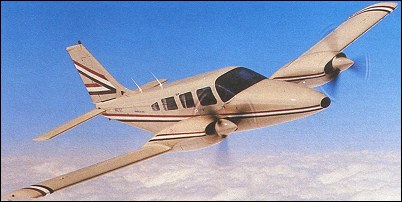|
| For 1972 Piper introduced the six/seven-seat Piper PA-34 Seneca which, basically, was a twin-engine version of the Cherokee SIX with retractable tricycle landing gear, a new fuselage structure and power provided by two 149kW Avco Lycoming IO-360 flat-four engines. For 1975 149kW Continental TSIO-360-E turbocharged and counter-rotating engines were introduced and the landing gear was streng-, thened for operation at higher gross weight, the designation then changing to PA-34-200T Seneca II. In 1982 the Seneca II was superseded by an improved PA-34-220T Seneca III, and this remains the current production version in 1984. It differs from its immediate predecessor by having more powerful Continental TSIO-360-KB turbocharged and counter-rotating flat-six piston engines. During 1976-77 Piper signed an agreement with the Polish foreign trade association Pezetel under which P.Z.L. Mielec will assemble/manufacture the Seneca for sale in eastern Europe. Designated in Poland as the P.Z.L. Mielec M-20 Mewa (gull), the first Polish-built prototype was flown on 25 July 1979. Current production version is the M-20 03 one of the very few light-twins on the market. A total of 4,464 Seneca were delivered by 1 January 1991.
| MODEL | Piper PA-34-220T Seneca III |
| ENGINE | 2 x Continental TSIO-360-KB, 164kW |
| WEIGHTS |
| Take-off weight | 2155 kg | 4751 lb |
| Empty weight | 1294 kg | 2853 lb |
| DIMENSIONS |
| Wingspan | 11.86 m | 39 ft 11 in |
| Length | 8.72 m | 29 ft 7 in |
| Height | 3.02 m | 10 ft 11 in |
| PERFORMANCE |
| Max. speed | 364 km/h | 226 mph |
| Ceiling | 7620 m | 25000 ft |
| Range | 1667 km | 1036 miles |
| JJ Watson, e-mail, 14.05.2011 22:11 Worked @ New Piper as a technical writer in 2001. nice job.
Couldn't stand the chatty tech reps next door. reply | | Mark, e-mail, 07.11.2010 00:27 Few lots of Seneca I, II, and III. They flew ok... You just had to learn to load them tail heavy then the landings were a bit better. reply | | Steven Nokes, e-mail, 26.10.2010 23:21 Sorry it was a 1000 hrs plus on article below reply | | Steven Nokes, e-mail, 26.10.2010 23:17 I owned a 1975 Seneca II 33012 for 12years an flew it over a 100 hours and even ran 1 of the engines 700 over TBO and loved the airplane. I even took out he seats and flew jet skis to the lake to use. Was totally amazed at how well the air craft flew. Still wish I had it to this day but Biz slowed down and it had to go. My worse story was when I was parked at a FBO in Walla Walla Wa someone stole all my radio package and what a expense that was so I didn't get a strike with my Ins Company. Wish I had 33012 back! reply | |
| | Melvin Brant, e-mail, 13.10.2010 23:11 I owned the Seneca II turbo with the Continental engines. I really enjoyed flying this model. The top speed indicated by the manufacturer is not a true indicator of what you can expect cross country which is dismal for a twin. The baffling on the Continental engines invited engine problems from overheating. I lost an engine on takeoff run and was able to shut down. The Cessna 210 turbo /press is a far superior aircraft in every way. reply | | Scott Boyd, e-mail, 25.04.2010 06:54 Probably the worst flying airplane I ever flew. The one I flew belonged to the Navajo tribe and had the fixed waste gate Continental engines. You could never keep the props in synch and any turbulence made it even worse. reply | | John Ellul, e-mail, 02.01.2007 16:16 The Seneca 1 was certfied with the aileron and rudder controls interconected for stability requirements. I fly an old Seneca 1 and wish to know how I can tell if the system is working. When I taxi the aircraft the control wheel does not move when I push the rudder pedal. Any help would be appreciated reply |
|
Do you have any comments?
|
| 
COMPANY
PROFILE
All the World's Rotorcraft
|






